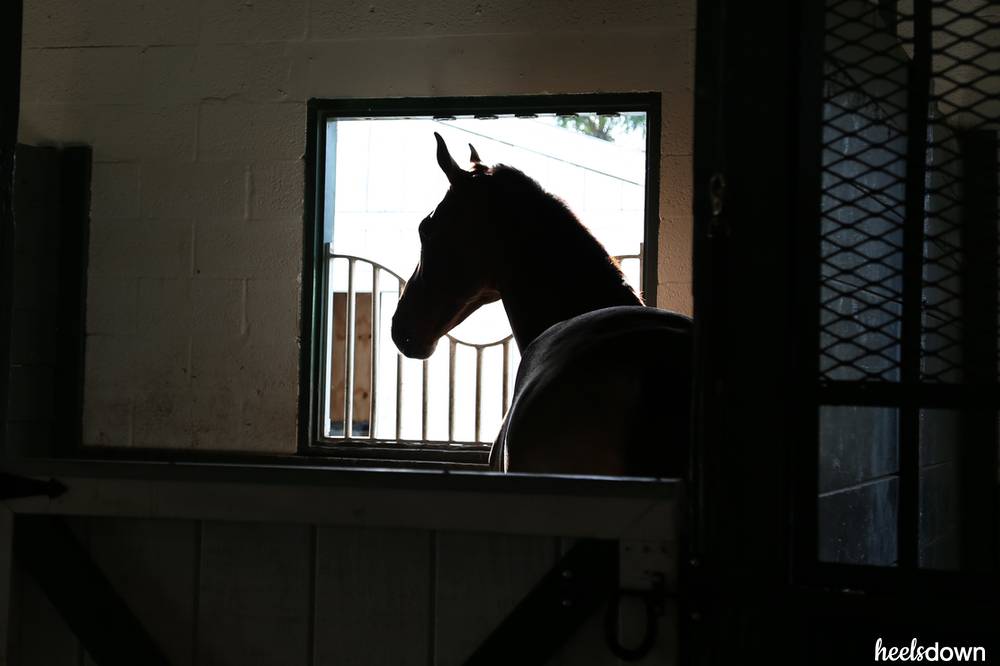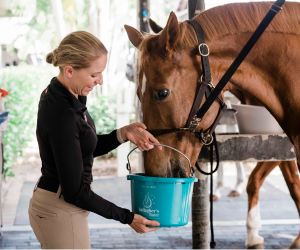Is Your Horse Barn Sour?

Take the quiz.
1. You decide to go out for a short hack in the field after a lesson. How does your horse respond?
a) He doesn’t mind one bit. He “blows out” contentedly and I ride around on a loose rein, enjoying the walk.
b) His ears prick up when headed toward the barn and he gets more pep in his step. Once I turn him away to head to the field, he bulges toward the barn and I have to use a lot of leg and rein to get him to turn and walk to the field.
c) The moment we step out of the ring, he is antsy and quick. When we turn toward the field, he either jigs or trots without being asked. He shows signs of agitation and anxiety by keeping his head high or shaking in frustration. He is tense, works himself into a sweat, and whinnies to his barn mates.
2. You’ve tacked up and are walking to the ring to mount. Your horse:
a) Walks quietly beside me, doesn’t crowd my space, and stops or slows when I do.
b) Is slow to leave the barn. Once walking, he tends to crowd my space or walk ahead of me. When I stop walking, he continues to walk ahead and sometimes turns around toward the barn.
c) Is quick and sensitive to his surroundings. Sometimes he spooks at ordinary objects (mounting block or the bush that’s never moved). He has a tendency to shove me when I am walking to try and turn back to the barn or his field mates. He doesn’t listen well to my vocal commands.
3. You are warming up in the ring and every time you head in the general direction of the barn, your horse:
a) Listens to my leg, maintains his frame and pace, and doesn’t get rushed or distracted.
b) Bulges in the direction of the barn, which makes me use more leg and voice. He loses his frame and our circle turns into a deformed oval. He is not able to keep a steady pace.
Like This Story? Try: Dealing With The Herd-Bound Horse
c) Gets agitated when he sees the barn or his field mates. He sometimes bolts, bucks, or thrashes his head to show irritation. I usually have to use strong aids and correct this behavior more than once. It takes a while to get him to focus on my aids.
4. You aren’t intending to ride, just groom your horse and hand graze him in that lovely back meadow with tons of clover. When you lead your horse out of view of the barn or his field mates, he:
a) Chows down on the clover like he hasn’t eaten in weeks.
b) Constantly faces the direction of the barn and takes a few bites. His ears are pricked in the direction of the barn with his head held high, looking for his friends.
c) Rarely eats between whinnies. It takes a while for him to calm down, and when he does, he is constantly looking for his friends with anxious whinnies.
5. Your horse has been let out for the evening with his fieldmates. You notice another rider leading a horse from your horse’s field. How does your horse respond?
a) He continues swatting flies and chowing down without notice. An absent field mate means more grass for him!
Read This Next: Shoe-Pulling Prevention 101
b) Nickers once or twice, trying to get his friend’s attention. He stays on the side of the field or fence closest to his friend’s location, but continues grazing with an attentive ear and eye in that direction.
c) Gallops or paces up and down the fenceline, whinnying for his companion. He never goes back to grazing and even works himself into a sweat.
6. You and your riding crew decide to hack in the field. You all walk down together. Once mounted you all take different areas of the field to warm up. Your horse:
a) Proceeds without a fuss away from the other horses and listens to your aids.
b) Turns away from the group, but continues to gravitate in their direction, which forces you to use stronger leg and redo your circle.
c) Fights to stay with the group and begins jigging when you walk away. He continues to tense up and prance while you try to warm him up; his attention is on the other horses and not you.
Mostly As
Your horse is comfortable with his surroundings and not herd-bound. He knows the world will not end if he can’t see his friends.
Mostly Bs
Your horse has a strong draw to the barn without getting dangerous or anxious. He would rather be with his friends or in his cozy stall, but he won’t fight you to the bitter end to go back. Keep reassuring your horse with transitions and ground pole work. His attention should be on you, so give him some exercises to make him work and think.
Mostly Cs
You have a herd-bound and insecure horse on your hands. Consistent work and patience is key to overcoming a herd-bound, barn-sour horse. Start small and simple, working your horse in an area of the farm or ring where he is comfortable. Even try some work on the ground, getting your horse to back up, turn, and follow you without you pulling or pushing. Your goal is to get his mind off of the herd and trusting you.


